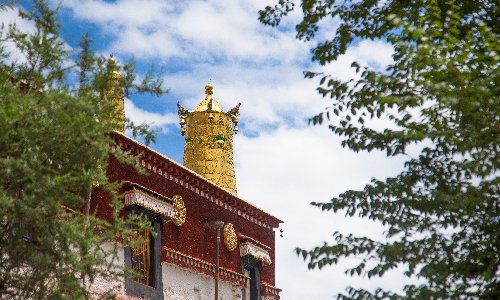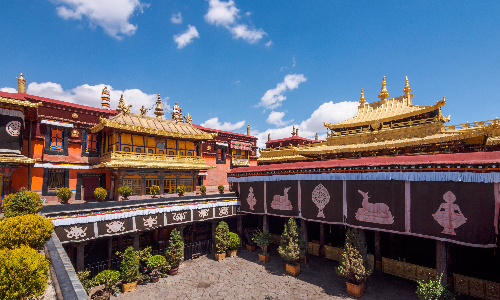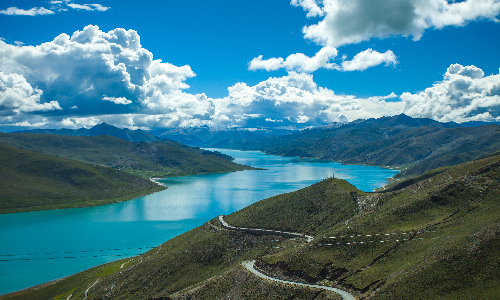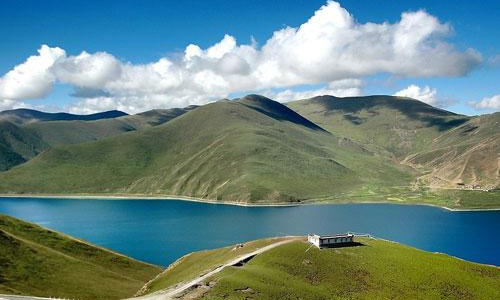Are you planning to visit Tibet? Are you looking for an in-depth Lhasa tour? Do you have about a week’s holiday? If your answers are yes, this 5 days Tibet tour is designed for you. You will have a panoramic tour in Lhasa with a visit to Yamdrok Lake. We have arranged almost all the worth-visiting tourist attractions in Lhasa, like the Potala Palace, Jokhang Temple, Bakhor Street, Norbulingka, Sera Monastery, Drepung Monastery, and one of the Three Holy Lakes in Tibet-Yamdrok Lake. During this tour, you will not only get a thorough knowledge of the history and culture of Tibet, but also enjoy the magnificent scenery of this mysterious land. China Tour Star will help you make the most out of your tour, and join us to visit Tibet!

Welcome to Lhasa, one of the globally highest cities, which lies on the roof of the world. Your wonderful tour begins here!
As the capital city of Tibet Autonomous Region, Lhasa is also known as a “Forbidden Kingdom” for its inaccessible high altitude reaching 3,650 meters. The awe-inspiring scenery of the city makes it one of the most popular cities among visitors to China. With its name referring to “the holy place”, Lhasa has a strong religious atmosphere and serves as a pilgrimage destination for Tibetan Buddhists.
When you arrive at the airport, our guide will pick you up and take you to the hotel for a good rest.
Warm tips:
1. In Lhasa, the amount of oxygen in the air is roughly a third less compared to that in the plains. So some visitors will have high altitude sickness that might include headaches, dizziness, and lack of appetite, etc. Therefore, upon arrival in Lhasa, you are recommended to have a rest in the hotel and consume plenty of fluids. And most importantly, try not to do any exercise even if you have a habit of exercising. The best way to avoid and reduce plateau reaction is to take some anti-plateau reaction drugs a week before entering Tibet.
2. The peak travel season in Tibet is between May and October each year. During this period, the weather is relatively nice, and the oxygen is sufficient. But there will be lots of tourists during these months. It is also nice to travel here in winter if you want to avoid the crowds. Although the weather will be cold, it is beautiful in Tibet as well. And some travellers praise that Tibet is even prettier in winter than in other seasons.
3. The temperature difference between day and night in Lhasa is huge. In summer, the temperature is 20 degrees during the day, but only about 10 degrees at night. And the temperature will be even lower in higher altitude areas. You must pay attention to keeping warm when you come to Lhasa, and bring warm clothes, such as a rash jacket, down jacket and warm pants.
4. The weather is pretty dry and the ultra violet ray is strong in Lhasa. So remember to drink more water, and bring sun protective things like sunscreen (better be SPF 50+), sunglasses, hats, and sun protective clothing.
Our trip starts with Norbulingka and the Drepung Monastery in the morning.
Norbulingka represents a typical Tibetan-style man-made garden as a summer residence for the successive Dalai Lamas to escape the heat of the dog days and deal with political and religious affairs. Literally, Norbulingka means “a park of treasure” in the Tibetan language. Norbulingka was firstly constructed in the 1740s and it took more than 200 years to finish. Then it underwent two major reconstructions. Originally it was built for other purposes. Yet because of its favorable environment, Norbulingka gradually became the summer residence of the Dalai Lamas.
The murals in Norbulingka are the most famous and unmissable things, which are related to Tibetan history, myths, and legends, including the origin of Tibetan people, biographies of different generations of Dalai Lamas, etc. Moreover, Norbulingka also teems with various distinctive plateau animals and plants. Now a hundred-meter-long corridor covered with wisteria flowers in Norbulingka has been a hot spot suitable for visitors to take pictures.
Norbulingka is usually crowded during the Shoton Festival. Also known as the yogurt festival, it is one of the biggest traditional Tibetan festivals lasting about a week (usually at the end of August). At that time, Norbulingka will see itself as a “sea of tents”. It is because that Norbulingka is the main venue for the performance of the Tibetan opera during the festival. The locals would dress up, take traditional food like butter tea and yogurt, and bring tents to Norbulingka. They usually stay there for a few days in their tents and go out to watch the performance when there is one.
Our next destination is Drepung Monastery. Constructed in 1416, it is the largest Tibetan Buddhism monastery which can accommodate more than 8,000 monks to chant sutras. Drepung Monastery is respected as the “mother monastery of Dalai Lamas” for its role in promoting the study of Buddhism and many important Tibetan leaders, especially the Dalai Lamas, used to study here.
The name “Drepung” means to “amass rice”, symbolizing prosperity. The reason why it got such a name accounts for the fact that the monastery has the magnificent white buildings row upon row on the slopes of a hillside, looking like a heap of rice afar. What is intriguing is that the monastery indeed enjoys the biggest kitchen among monasteries in Tibet. And some of the antique cookware that gradually disappeared in other areas are still being used here.
The entrance of the monastery is at the top of a hill, that is, a necessary but easy climb is required for you to get to the monastery. Once you arrive at the top of the hill, what greets you is not merely treasure sculptures and murals but also an elegant panoramic view of the city of Lhasa.
The most significant Buddhist activity in the monastery is to unfurl the colorful silk-woven portrait of Shakyamuni, the founder of Buddhism. Such an activity has been held in the monastery since the 11th century, and it is held every year to kick off the Shoton Festival.
What needs to be noticed is that taking pictures is not allowed in the monastery. At the same time, sunglasses and hats are not recommended and your clothing cannot be too casual.
After lunch at a local restaurant, Sera Monastery will start our journey in the afternoon. Sera Monastery was firstly built in 1419 by Sakya Yeshe, a disciple of Tsongkhapa (the founder of the Gelugpa school of Tibetan Buddhism), and finished in 1434. Because the monastery was perched on a hillside surrounded by rose bushes, which pronounces as “sera” in the Tibetan language, it hence got such a name. And the scenery of the monastery lives up to its name that it is regarded as one of the most beautiful monasteries in Tibet.
Sera Monastery has always been a place for masters of Buddhism to interpret and debate sutras. There is even a specific debating courtyard for monks in the monastery. Debating is highly stylized and happens every afternoon (from Monday to Saturday, except for public holidays) around 3 p.m. The young monks will scatter in groups of two or four to practice their philosophy through debating with one another. And visitors are welcomed so long as you show your respect to them. The debate is the most popular activity among the visitors even though they do not know what the monks are talking about. Except for the must-see sutra debate, visiting statues of Buddha, collections of sutras, exquisite thangkas, as well as piles of embroidery and murals in the monastery are also good choices.
That is the end of our second-day trip! You will be picked up and sent back to the hotel.


The third-day trip begins with the Potala Palace after breakfast. Corresponding to the “summer palace” - Norbulingka, the Potala Palace is known as the “winter palace” for generations of Dalai Lamas as they will live here in winters. As an iconic landmark of Lhasa, the Potala Palace was originally built during the reign of King Songtsen Gampo, who founded the Tibetan empire which ran for about 200 years in the 7th century. It is said the construction of the Potala Palace is for a gesture of love, that is, to celebrate King Songtsen Gampo’s marriage with Princess Wencheng in the Tang Dynasty (618-907).
The name of “Potala” is translated from the word “Potalaka” in Sanskrit that means “small white flowering tree” and “land of light”. The Buddhist legend says that “Potala” is an abiding place of the Bodhisattva, a god that was taken by Songtsen Gampo as his patron saint. He hence named the palace “Potala”. And now the palace remains a mecca for Buddhists in the world, and every day it would witness a large number of pilgrims circle the palace to ask for blessings.
The Potala Palace is situated atop a mountain at an elevation of over 3,700 meters above sea level, representing the world’s highest palace. Furthermore, “the sweetest palace” is another name of the Potala Palace. The walls of the palace are painted with a formula of saffron crocus, lime, sugar, honey, and milk. And the painting will be done every year on September 22 in the Tibetan calendar for welcoming the inventor of Buddhism, Shakyamuni, who returned to the real world on that day according to legend.
It is also noteworthy that the iconic view of the Potala Palace is seen on the back of fifty yuan notes.
Photography is forbidden inside the Potala Palace and if you take photos, your camera will be confiscated and you will probably be in trouble.
After lunch, we will visit Jokhang Temple and Barkhor Street.
The Jokhang Temple was built in 647 for celebrating the marriage of Songtsen Gampo and his two wives, Princess Wencheng of the Chinese Tang Dynasty and Princess Chizun of Nepal. The temple is designed to enshrine a life-sized golden statue of 12-year-old Shakyamuni and the statue of the Akshobhya Buddha that were respectively brought by two princesses as a part of their dowries. The two statues enshrined in the Jokhang Temple make it the “spiritual heart of the city” and the most sacred temple in Tibet.
A saying spread across the Tibetans is “there stands the Jokhang Temple before the emergence of the city of Lhasa”. Now, many pilgrims would circle the temple while spinning prayer wheels every day. They do this to accumulate good karma in hopes of getting a better afterlife.
As a matter of fact, the name “Lhasa” is originated from the Jokhang Temple. Lhasa was once called “Rasa” in which “ra” means a ram and “sa” stands for land, referring to a land built by rams. After the completion of the Jokhang Temple, it was regarded as the most sacred Buddhist temple in Tibet. And the people in the city Rasa where Jokhang Temple is located thought it would be better to relate the name of the city with Buddhism. Then, “Rasa” was renamed as “Lhasa”, because “la” means “Buddha” in Tibetan.
The monastery stands four stories high and spreads over an area of about 25,000 square meters. The golden roof in the monastery shows us the blend of Tibetan elements with the temple style of Nepal, mainland China, and India. Originally it was composed of only eight halls. But later on, it was renovated and expanded to the grand monastery it is today.
A festival called the Great Prayer Festival will be held here every year. And this biggest religious festival in Tibet will last from January 1st to January 25th in the Tibetan calendar. Thousands of monks from the three great monasteries (Ganden Monastery, Drepung Monastery, Sera Monastery) would gather here to chant prayers and to perform religious rituals.
A kind reminder, cameras are not allowed inside the temple.
Surrounding the Johkang Temple, Barkhor Street is a circular street around the temple. It is a circled one-way road for praying and is the well-known kora route. Kora refers to the pilgrimage with meditation exercise, typically performed by practitioners making circumambulation around things that are holy. Local Tibetan believed that exercising the Kora can renounce all the evil or suffering, leading the prayers to endless virtues and profound knowledge.
In the beginning, the street was just a path around the temple trodden by the Buddhist pilgrims around the Jokhang Temple to pray for blessing. Over time, it became one of the “holy road” among the devout pilgrims. You still can see lots of Buddhist pilgrims paying worship to the Jokhang Temple today.
With strong cultural and religious atmosphere, the street remains its ancient looks and represents the lives of the locals. It’s one of the rare places in the city that has not changed much through the centuries.
The street now serves as the busiest commercial and commodity-distributing spot in Lhasa. A maze of alleys radiates out from the street, and all of them are crammed with stores, selling traditional handicrafts and Tibetan Buddhist knickknacks. You can get all sorts of Tibetan souvenirs here on Barkhor Street.
The most famous and must-see place in the street is probably the restaurant of Makye Ame. It is said that the restaurant once served as a dating place for a lady named Makye Ame and the sixth Dalai Lama, Tsangyang Gyatso. It offers fusion food and is decorated in bright yellow, a color which is rare in Tibet and just for monasteries and houses of the widely-respected monks. You will have some free time here on the street.
Having finished the tour for today, we will pick you up and send you to the hotel.

 Yamdrok
Yamdrok Lhasa
Lhasa Today we will head to the Yamdrok Lake after breakfast. Yamdrok Lake is located in the southwest of the city of Lhasa, and it is estimated to take about 2 hours for 100 kilometers to get there.
Referring to “a turquoise blue lake above the pasture” in the Tibetan language, Yamdrok Lake is one of the lakes with numerous myths and legends. It is said that the Yamdrok Lake originally consisted of nine separate lakes. A fairy feared that individual lakes would dry up fast without connection with other lakes, and the aquatic lives would be in danger. So she threw a handful of gold dust into the lake and created channels that connect the nine lakes, and successfully saved the lives in the area. Such a legend has been passed on until today and Tibetans believe the lake is the lifeline for the inhabitants.
Covering over 1,631 square kilometers of water areas, Yamdrok Lake represents the largest inland and freshwater lake in southern Tibet. The lake winds erratically through mountain ranges. As a result, no matter where you stand, you can easily find its beauty. But due to the same reason, it’s hard to see the whole picture of the lake. Therefore, the lake is also called “turquoise earrings scattered by the Goddess”.
The locals refer to the lake as a coral lake as it is in a coral shape with streams emptying into it from nearby mountain ranges. Sometimes it is also called the jade lake for its smooth surface resembling a fine jade with gorgeous color hues reflected by sunlight.
The lake is also regarded as one of the three “sacred lakes” in Tibet. The reason lies in the legend which says that the lake is the incarnation of the daughter of the Dragon King, who is also the female dharma protector in Tibetan Buddhism. Moreover, Buddhists believe that the lake can help them find the boy who possesses the reincarnated soul of the Dalai Lama. In this ritual of finding the reincarnated soul, the monks will gather on the shore of the lake, chanting and praying, then throw a ceremonial scarf symbolizing purity into the sky and towards the lake, and finally look at the reflection of the scarf on the lake to determine the location of the Dalai Lama’s reincarnated soul. It is said that devout Buddhist pilgrims would journey to the lake to pray, meditate, or seek wisdom, and the journey usually lasts one month every year.
After some time here, your guide and driver will take you back to Lhasa.


The fifth day represents our departure time from the spectacular city of Lhasa. We believe that you have had an unrivaled journey for spiritual awakening here. We are looking forward to seeing you in the future! Your guide will pick you up from your hotel lobby and transfer you to the airport according to your flight schedule.
Author: Chen Siqi
Proofreader: Li Yiwen
| City | Five Star hotel list | Four Star hotel list |
|---|---|---|
| Lhasa | Shangri-La Hotel, Lhasa | Thangka hotel |
 |
![]() About your child or infant, please contact us for a discounted price.
About your child or infant, please contact us for a discounted price.



We started with a few days in Beijing & ended in Shanghai, from where we visited the Forbidden City and Great Wall. In between we visited Terra Cotta Warriors Museum, Panda Base, Shanghai Disneyland.

We had a wonderful holiday in China which will remain long in the memory. China is a breathtakingly beautiful country full of splendid temples and palaces, mountains and rivers, peaceful rural scenes and bustling shopping streets.
 QUICK ENQUIRY
QUICK ENQUIRY